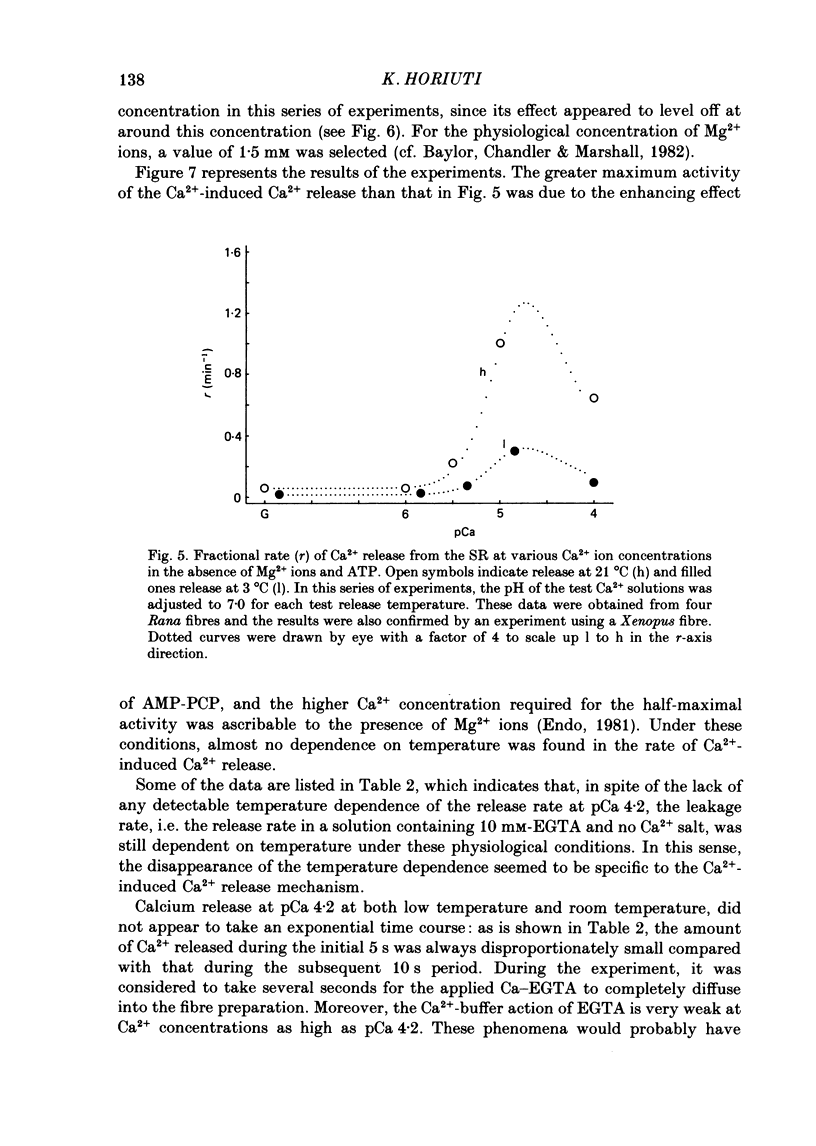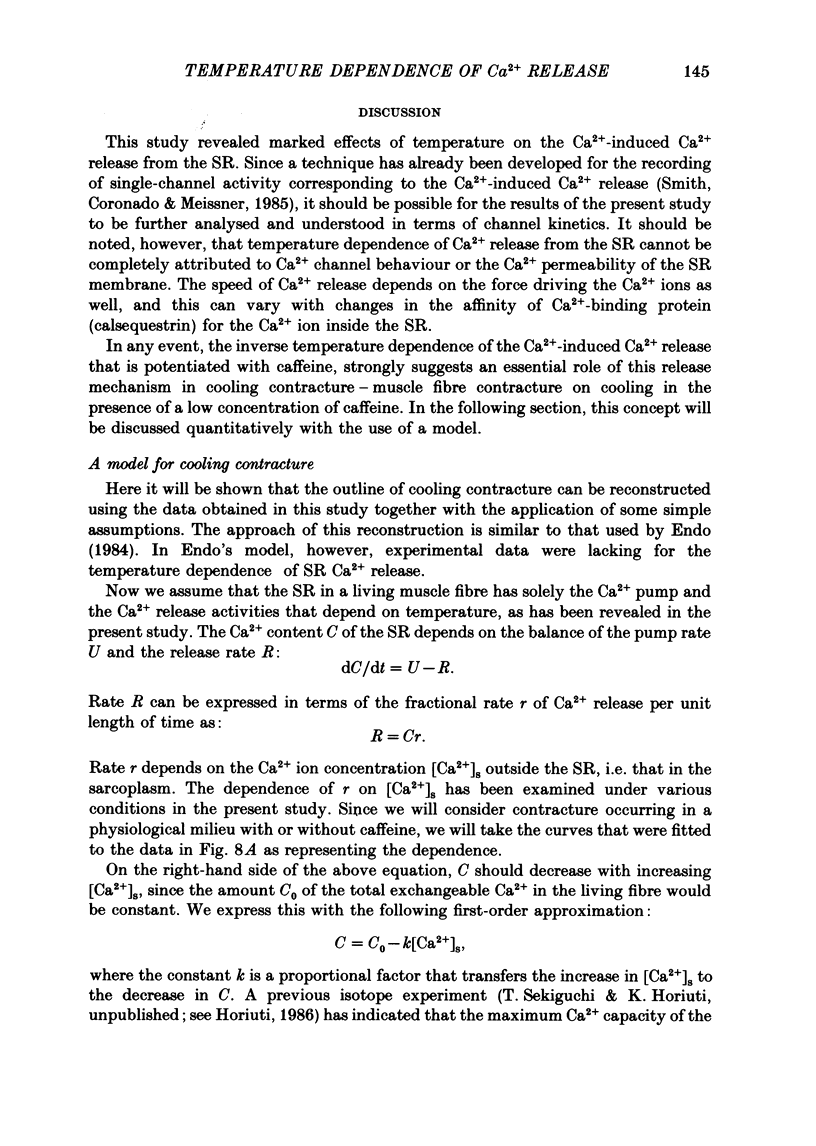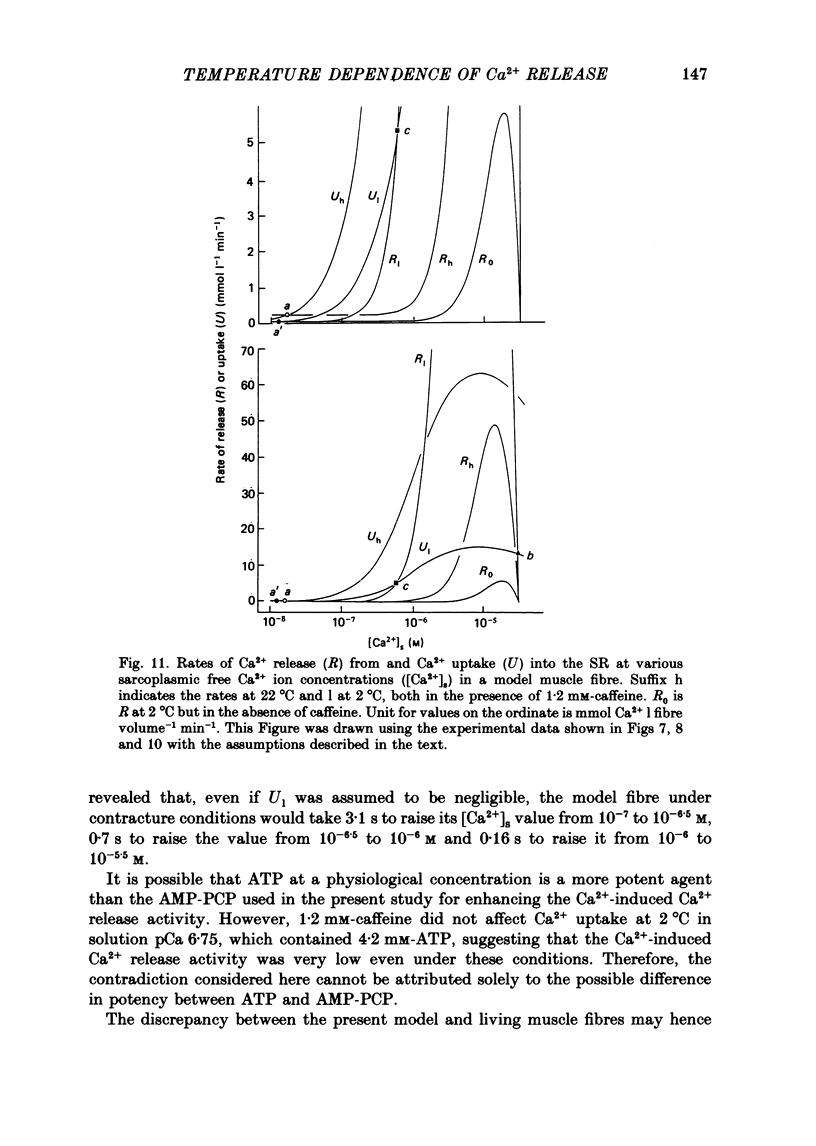Abstract
1. In order to clarify the mechanism of contracture on cooling of caffeine-treated intact muscle fibres, the temperature dependence of a calcium (Ca2+) release mechanism, 'Ca2+-induced Ca2+ release', of the sarcoplasmic reticulum (SR) was examined in skinned frog muscle fibres. 2. Skinned fibres in a solution containing 1.2 mM-caffeine and 0.7 mM-EGTA (Mg2+, 1.5 mM, Mg-ATP, 3.5 mM, pH 7), contracted on cooling (from 22 to 2 degrees C) due to Ca2+ release from the SR. 3. The rate of Ca2+ release from skinned fibre SR in a medium which contained Ca2+ ions (with 10 mM-EGTA) and no ATP salts, was determined under various conditions using the 'caffeine method.' 4. In the absence of Mg2+ ions, adenine nucleotides and caffeine, the rates at room temperature (21-22 degrees C) were 3-4 times greater than those at a lower temperature (1.5-3 degrees C), at any concentrations of Ca2+ ions external to the SR. 5. In the presence of Mg2+ ions (1.5 mM) and beta,gamma-methylene ATP (1 mM), the effect of temperature on the rates disappeared in Ca2+-containing media, although the effect remained in Ca2+-free medium. 6. When caffeine (1.2 mM), which is a potentiator of the Ca2+-induced Ca2+ release, was added to the test medium with Mg2+ and beta,gamma-methylene ATP, the resulting potentiating effect was several times greater than that at lower temperature. 7. In order to examine the temperature dependence of the Ca2+ pump activity of the SR, the initial rate of Ca2+ uptake by the empty SR was determined under various conditions in the presence of Mg2+ ions (1.5 mM) and Mg-ATP (3.5 mM). The Q10 of the pump activity was around 2.0 at the Ca2+ ion concentrations examined (less than 10(-6) M). 8. A numerical model based on the results obtained, together with some reasonable assumptions, suggested that both suppression of the Ca2+ pump and enhancement of the Ca2+ release contribute to the cooling contracture of caffeinized fibres.
Full text
PDF

















Selected References
These references are in PubMed. This may not be the complete list of references from this article.
- Baylor S. M., Chandler W. K., Marshall M. W. Optical measurements of intracellular pH and magnesium in frog skeletal muscle fibres. J Physiol. 1982 Oct;331:105–137. doi: 10.1113/jphysiol.1982.sp014367. [DOI] [PMC free article] [PubMed] [Google Scholar]
- Baylor S. M., Chandler W. K., Marshall M. W. Sarcoplasmic reticulum calcium release in frog skeletal muscle fibres estimated from Arsenazo III calcium transients. J Physiol. 1983 Nov;344:625–666. doi: 10.1113/jphysiol.1983.sp014959. [DOI] [PMC free article] [PubMed] [Google Scholar]
- Horiuti K. Some properties of the contractile system and sarcoplasmic reticulum of skinned slow fibres from Xenopus muscle. J Physiol. 1986 Apr;373:1–23. doi: 10.1113/jphysiol.1986.sp016032. [DOI] [PMC free article] [PubMed] [Google Scholar]
- Kakuta Y. Effects of ATP and related compounds on the Ca-induced Ca release mechanism of the Xenopus SR. Pflugers Arch. 1984 Jan;400(1):72–79. doi: 10.1007/BF00670539. [DOI] [PubMed] [Google Scholar]
- Konishi M., Kurihara S., Sakai T. Change in intracellular calcium ion concentration induced by caffeine and rapid cooling in frog skeletal muscle fibres. J Physiol. 1985 Aug;365:131–146. doi: 10.1113/jphysiol.1985.sp015763. [DOI] [PMC free article] [PubMed] [Google Scholar]
- Ogawa Y. Some properties of fragmented frog sarcoplasmic reticulum with particular reference to its response to caffeine. J Biochem. 1970 May;67(5):667–683. doi: 10.1093/oxfordjournals.jbchem.a129295. [DOI] [PubMed] [Google Scholar]
- Smith J. S., Coronado R., Meissner G. Sarcoplasmic reticulum contains adenine nucleotide-activated calcium channels. Nature. 1985 Aug 1;316(6027):446–449. doi: 10.1038/316446a0. [DOI] [PubMed] [Google Scholar]
- Weber A., Herz R. The relationship between caffeine contracture of intact muscle and the effect of caffeine on reticulum. J Gen Physiol. 1968 Nov;52(5):750–759. doi: 10.1085/jgp.52.5.750. [DOI] [PMC free article] [PubMed] [Google Scholar]
- Weber A. Regulatory mechanisms of the calcium transport system of fragmented rabbit sarcoplasmic rticulum. I. The effect of accumulated calcium on transport and adenosine triphosphate hydrolysis. J Gen Physiol. 1971 Jan;57(1):50–63. doi: 10.1085/jgp.57.1.50. [DOI] [PMC free article] [PubMed] [Google Scholar]
- Yount R. G., Babcock D., Ballantyne W., Ojala D. Adenylyl imidodiphosphate, an adenosine triphosphate analog containing a P--N--P linkage. Biochemistry. 1971 Jun 22;10(13):2484–2489. doi: 10.1021/bi00789a009. [DOI] [PubMed] [Google Scholar]


